“What trail truck should I get?” It’s still the number one “help me pick a thing” question we get, and the field of choices is larger than ever. Three trucks remain firmly in place as the most likely picks: Axial SCX10 II, Traxxas TRX-4, and Vaterra Ascender. With new versions of all three models now on shelves, including the low-buck Sport version of the TRX-4, we decided it was time to hit the trail with all three to see how they stack up. Axial rolls out with the latest ’69 Chevy Blazer skin in an open-top configuration complete with driver; Vaterra’s Ascender arrives in its maximum-wheelbase configuration wearing its new Suburban look; and Traxxas has chopped a big chunk out of the TRX-4’s price by eliminating the High/Low transmission and T-Lock differentials from the new Sport model, which puts it much closer in spec to the Axial and Vaterra trucks. Let’s measure, inspect, drive, and discuss…

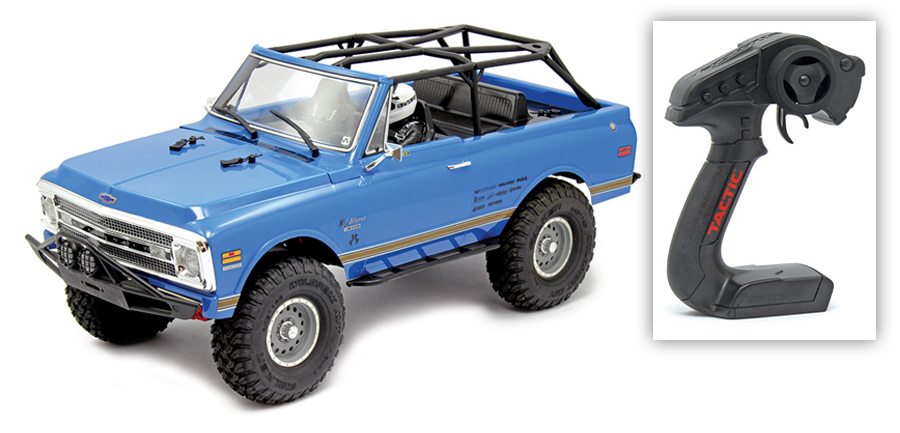
At $420, the Axial rig is the most expensive one here, but it’s also the only one with an interior of any type, a roll cage, and a set of soft replica tires (Falken Wildpeaks). LEDs are a nice touch too, but you’ll also find those on the low-cost champ of this shootout, so there. If you want to go SCX10 II on a budget, you can go all the way down to $300 with the Deadbolt—FYI for you penny pinchers. Tech-wise, there are no changes to the SCX10 II platform, and the AR44 axles are the star of the show with their minimum-diameter, spiral-cut ring gears and lifted pinion gears that improve ground clearance.
QUICK SPECS
Price: $420
Length: 22.00 in. (559mm)
Width: 9.50 in. (241mm)
Wheelbase: 12.00 in. (305mm)
RTR requires: Battery, charger, and AA batteries
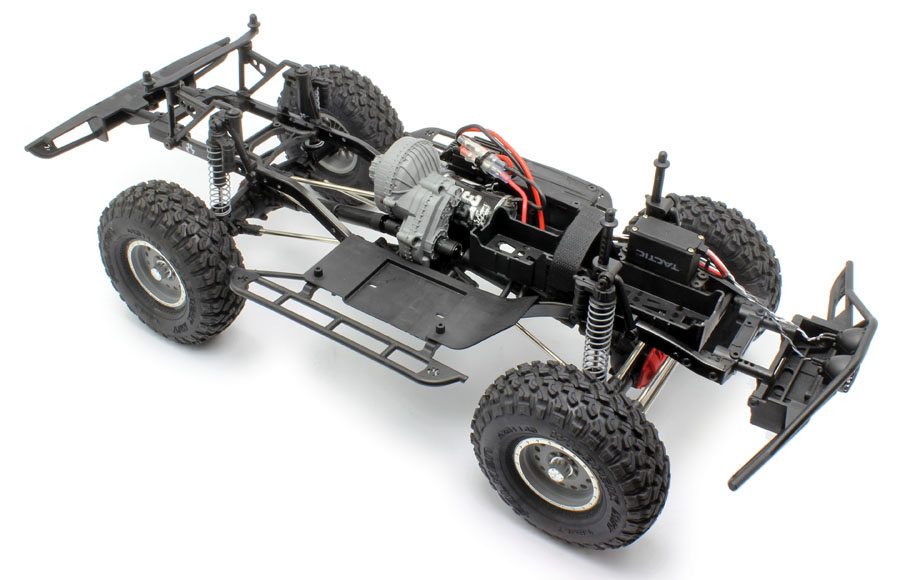
The SCX10 II chassis places the battery over the front axle, where its weight can do the most good.
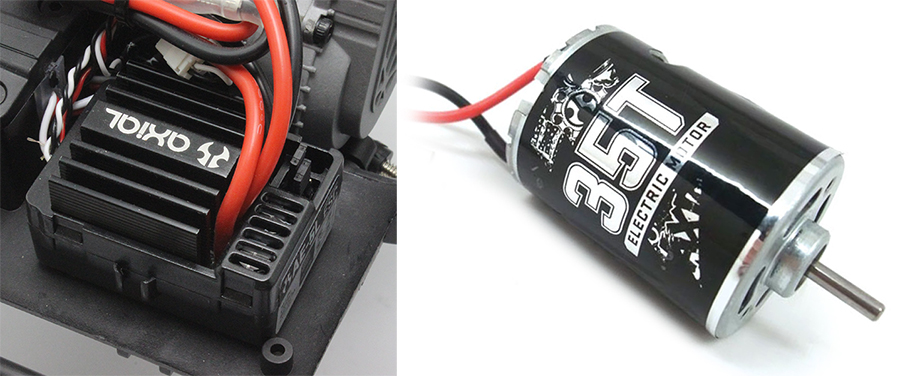
The AE-5L speed control uses jumpers to select LiPo or NiMH mode and to set drag brake to 50 or 100%, while the 35-turn brushed motor provides plenty of torque to attack the rocks with ease.
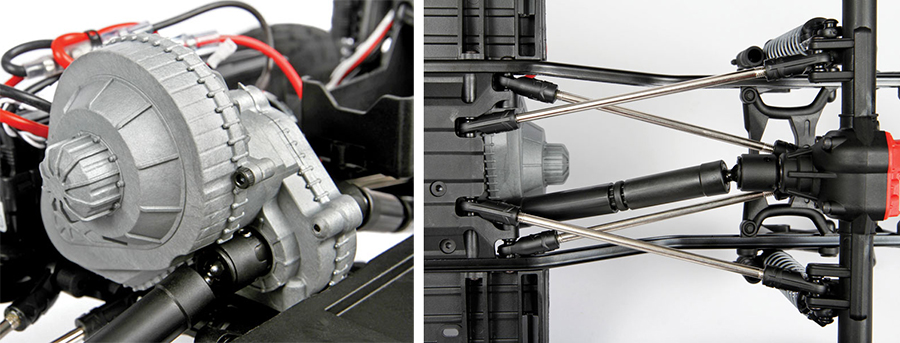
The new transmission housing is molded to look like cast aluminum. The final gearing is 42:1, which is lower than the 33.06:1 ratio used in the past. The suspension links are solid-steel rods and work fine, but the plastic rod ends can catch on rocks.


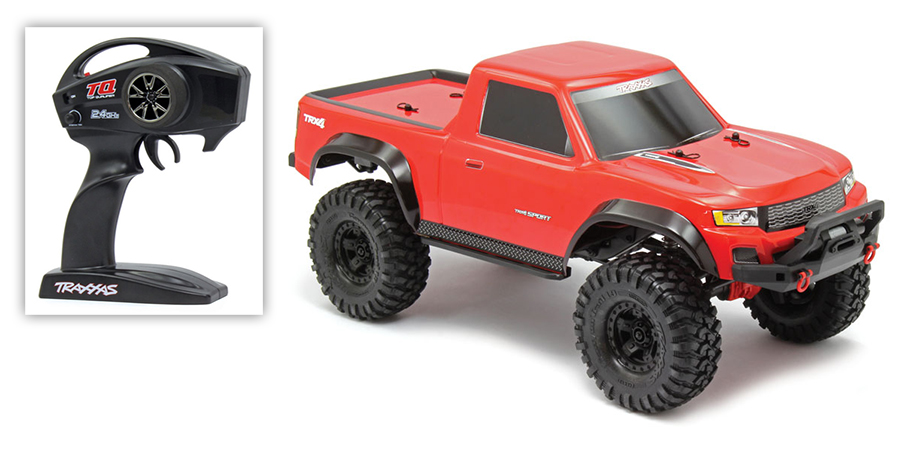
The standout feature of the Traxxas TRX-4 is its portal axles, which provide the most ground clearance out of all the trucks in the shootout. Another benefit to the design is that it raises the suspension links and gets them out of the way, and the extra gearing used to connect the driveshafts to the output shafts gives the axles an incredible amount of gear reduction and virtually eliminates torque twist. To cut costs, Traxxas eliminated the locking diffs and 2-speed transmission of the other TRX-4 models, and the included radio is a “just plain TQ” instead of the Bluetooth-upgradable TQi. The nice thing is that you can purchase the parts to install those features in the Sport if you choose to do so.
QUICK SPECS
Price: $360
Length: 21.90 in. (557mm)
Width: 9.80 in. (249mm)
Wheelbase: 12.30 in. (312mm)
RTR requires: Battery, charger, and AA batteries
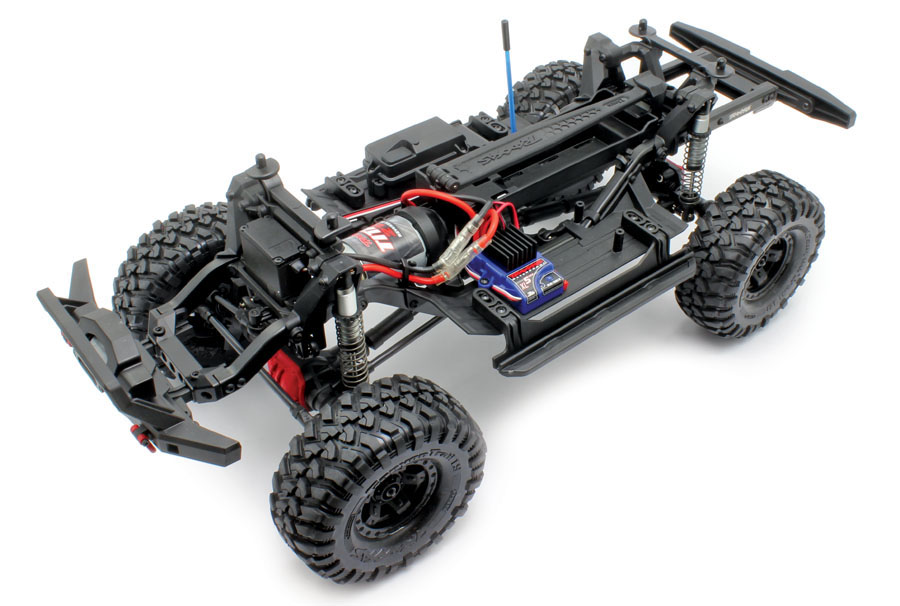
The TRX-4 looks downright tanklike compared to the other trucks, and its motor placement is unique. The rear-set battery tray, however, takes some weight off the front axle.
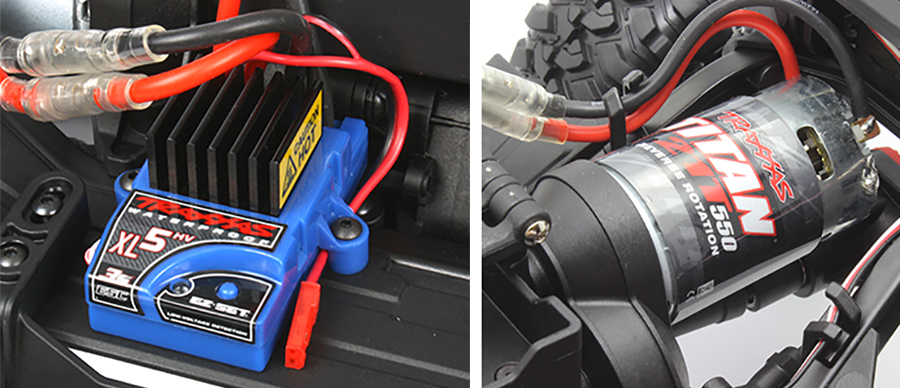
The XL-5 HV speed control is rated for 3S LiPo batteries and features a Trail and Crawl modes specific to the TRX-4. The reverse-rotation Titan motor gives the TRX-4 Sport a good blend of torque (thanks to the long 550-size can) and speed (via the 21-turn armature).
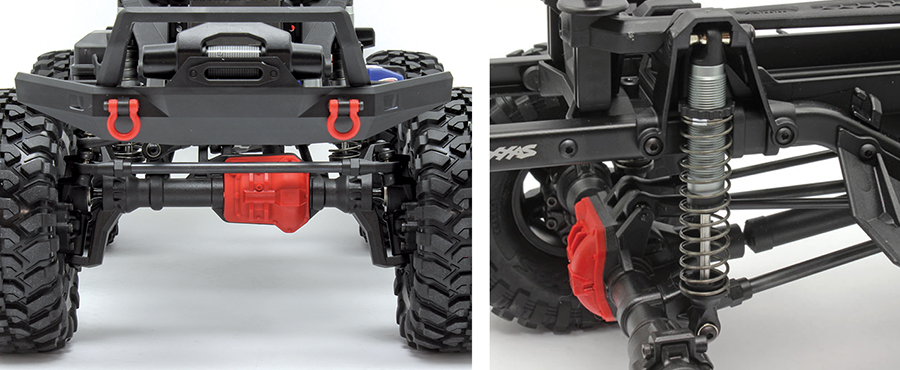
Portal axles are the standout feature of the TRX-4 Sport. In addition to offering the most ground clearance of the three trucks, the portal design’s increased gear reduction virtually eliminates torque twist. Durable aluminum shocks provide damping, and their bodies are threaded for easy ride-height adjustment.
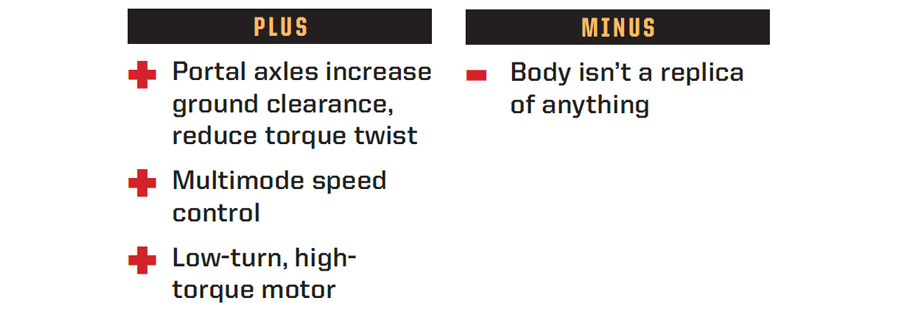

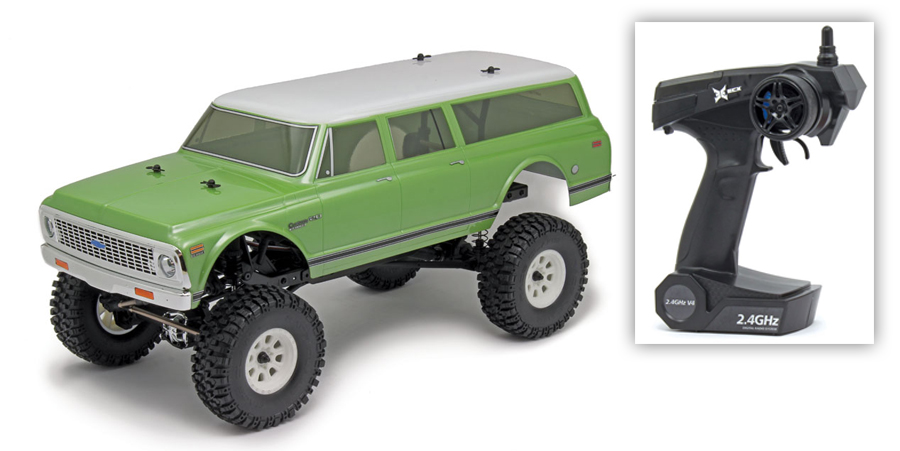
The Suburban is the first Ascender to use the maximum-wheelbase position of the chassis’ clever adjustable-wheelbase feature, and it also gets a new transverse battery tray that can hold full-size LiPo packs (the old tray was for “shorty” packs only). Less obvious new features include hybrid suspension links, which appear to be one-piece plastic units but are actually molded over steel rods, and plastic gears in the transmission to help get the Suburban down to its rock-bottom $280 price. Another cost saver is the radio system, which is a perfectly good 2.4GHz unit but not as nice as the genuine Spektrum-brand DX2E that has equipped previous Ascenders.
QUICK SPECS
Price: $280
Length: 19.50 in. (495mm)
Width: 8.00 in. (203mm)
Wheelbase: 12.36 in. (314mm)
RTR requires: Battery and charger
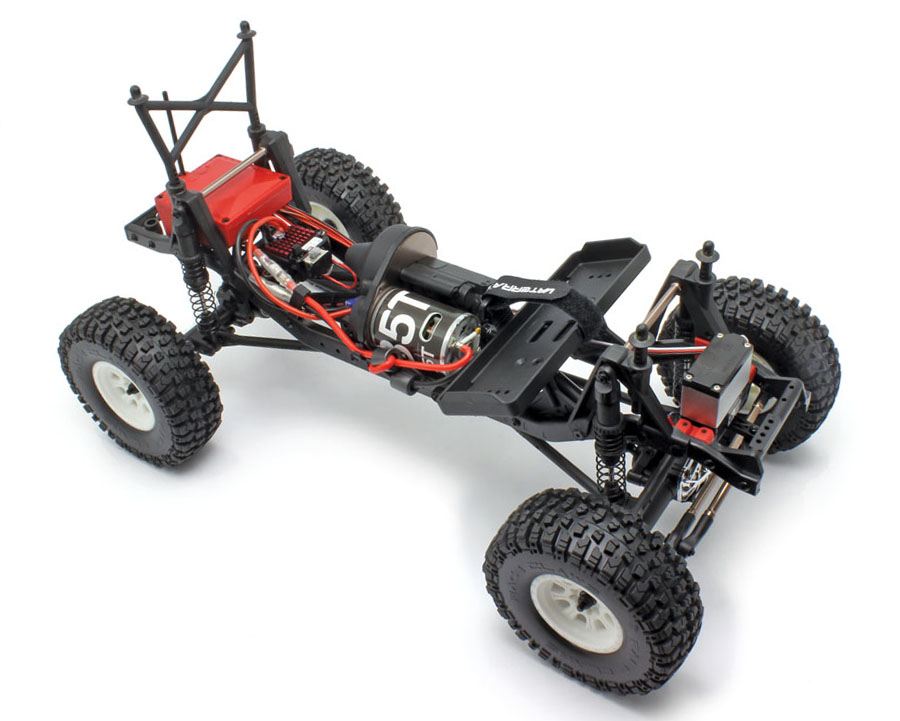
The Ascender is the slimmest-looking truck of the bunch, with no “running boards” to scrape on obstacles.
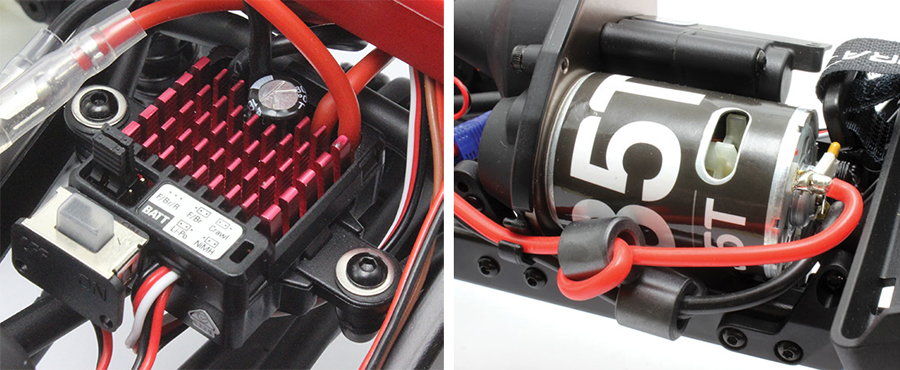
The included waterproof 60-amp speed control includes hard tabs that are used to securely fasten the speed control to the chassis. You can alter the drive mode from Standard to Crawl, and change the battery type by moving the small tabs on top.The Dynamite 35-turn motor provides plenty of torque for the trails and plenty of run time.
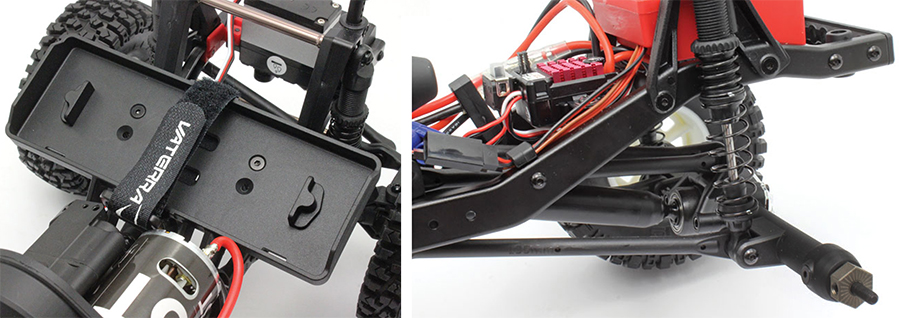
Vaterra has eliminated the shorty-only floating battery tray in favor of a conventional fixed-position tray that accepts both shorty and standard-size battery packs. The suspension links are plastic over steel. They slide easily over rocks, and there are no threaded ends to fail.


Comparison Testing
Stock & Modified Testing
In addition to testing the SCX10 II, TRX-4, and Ascender as they came out of the box, we also ran them with matching sets of Pro-Line Hyrax tires on Impulse black/silver plastic internal beadlock wheels for a more direct comparison of each chassis’ capabilities. All the trucks were tested with identical Venom Drive 5000mAh 2S LiPo batteries, so no truck had a voltage or capacity advantage.
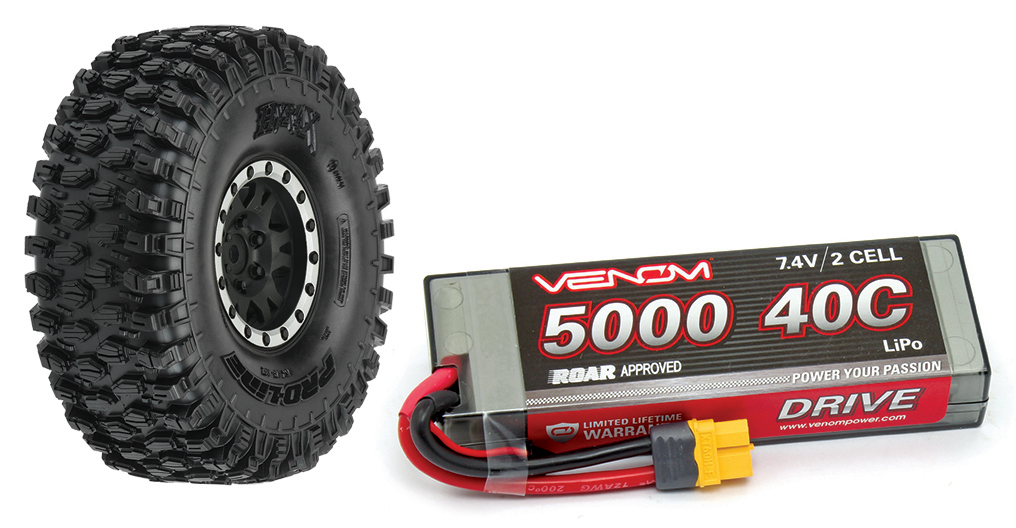
Ramp Travel Index (RTI)
To calculate RTI, we ran each truck up a 20-degree articulation ramp, which is standard for full-size trucks. After running each truck up the ramp to its maximum articulation, we applied the same formula used by full-size off-roaders. More articulation isn’t necessarily better, but not enough is definitely a problem (though not one any of these trucks have).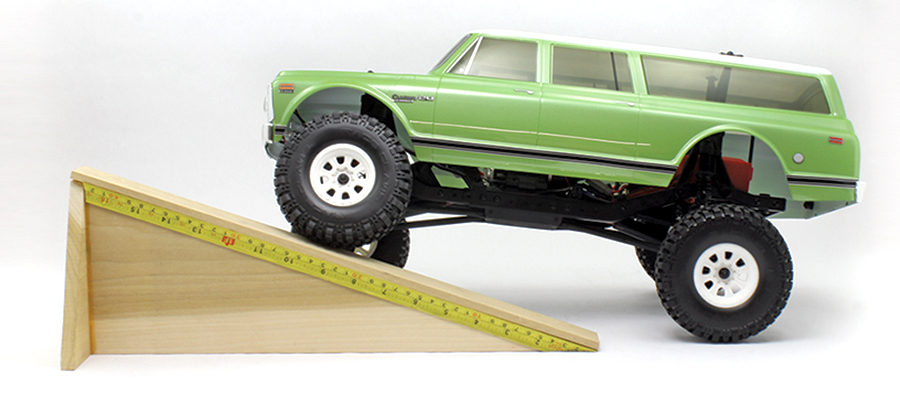

Weight Distribution
All three trucks were weighed using a GForce X Weight 4-scale Vehicle Weight Gauge to see where the weight bias was located. Before weighing happened, Venom Drive 2S 5000mAh 40C LiPo batteries battery packs were installed. Weights are shown for the trucks in stock trim.

Sidehilling
To check the sidehilling capability of each truck, we tipped them on a board until they rolled over and measured the maximum angle that they were able to achieve before they tipped over. Static testing like this makes the trucks seem closer than they feel on the trail, where the trucks have to deal with uneven terrain in addition to the hill angle. It’s worth noting that angle testing without bodies showed all three trucks to be equally stable at 48 degrees; body height and weight is what makes the difference.
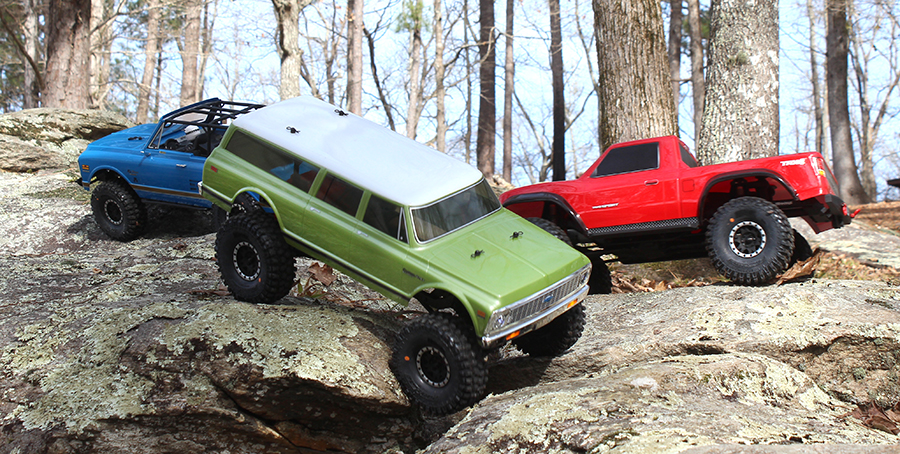
Ground Clearance
We rolled each truck over a ride-height gauge to measure ground clearance at the differential. Since tire height plays a role, we also measured the trucks with identical Pro-Line tires. No matter how you slice it, the TRX-4’s portal axles offer a big advantage, with nearly a full half inch of extra ground clearance.

Speed Testing
No one is looking for a trail truck to go fast, and more speed isn’t necessarily better—if anything, slower means lower gearing and more torque. More speed means higher wheel rpm, and sometimes that’s what you need to get through a section. So don’t read too much into speed, but it is interesting to see how the trucks compare. Speed is listed in feet per second (fps) as well as miles per hour (mph).
Driver’s Comments
Kevin Hetmanski
Axial SCX10 II
Kevin Hetmanski: The SCX10 II was planted on most surfaces, although the tires had more sidewall flex than I’d like to see. The SCX10 II felt more at home on the rocks after we switched over to the Pro-Line Hyrax tires. The front-set battery tray, slim axles, and proven SCX10 geometry make this a capable truck right out of the box, but the steel-rod suspension links are easy to catch on rocks at the shoulders of their plastic rod ends. They’re the only thing I’d change right away.
Traxxas TRX-4
Kevin Hetmanski: Impressive features, such as the portal axles, raised links, and aluminum shocks, make this truck the one for me. The portals do a great job of getting over stuff that hang up standard trucks, and that makes it easier to get from point A to point B. The aluminum shocks are ultra smooth and provide durability on the trail. I also give Traxxas the nod for providing compworthy tires. I felt that they performed as well as the Pro-Line tires that we used to level the field. The front end was a little light on steep inclines, but that’s nothing that a little stick-on weight can’t fix.
Vaterra Ascender
Kevin Hetmanski: I like the Suburban body, but the white plastic wheels give it a toyish appearance. The stock rubber is firm, but the tires perform better than expected. If you’re hitting what I call a light-duty trail, they’re perfectly fine. I like how Vaterra took care of the links; they’re extremely durable, thanks to their one-piece design and included steel insert, and they slide easily over rocks. The Pro-Line tire change made the biggest difference in performance on this truck, and it also gave it a great look.
Adam Dingler
Axial SCX10 II
Adam Dingler: I really enjoyed the smooth throttle response of the SCX10 II, and I felt that the drag-brake setting was on the money. I was a little disappointed to see that there was some tire rub on the body. A little trimming will fix that, but it’s a shame to carve up the Blazer body, which looks really nice. I was happy with the performance of the stock rubber, but the Pro-Line Hyrax tires woke it up a little more. If I had to pick only one, the SCX10 II would be my choice, despite its higher cost.
Traxxas TRX-4
Adam Dingler: The Traxxas TRX-4 is a great truck out of the box. I’m impressed with the performance of the stock tires, and was happy to see that there was plenty of room in the wheel wells to allow the tires to tuck in without rubbing. The portal axles did a great job of getting over various obstacles that hung up the other trucks. The battery position hurts the truck when making climbs up steep angles. Adding a little more weight over the front end would do a great job of keeping the tires down.
Vaterra Ascender
Adam Dingler: I really like the look of the Suburban body. It’s my favorite of the group. As with the SCX10 II, there was some body rubbing, and that’s a little disappointing. The stock-tire compound is firm, and that allowed some slippage when the other trucks hung on. This truck came alive when we switched over to the Pro-Line tires, and it was able to get over obstacles that it couldn’t before. The lower price of the Ascender is a bonus; the extra cash that that you don’t spend on it gives you a little more money for upgrades.
Matt Smith
Axial SCX10 II
Matt Smith: I was impressed with the SCX10’s scale appearance. The attention to detail really shows. The truck’s power delivery is buttery smooth, with plenty of torque for just about any obstacle. The soft-compound tires conform well and provide great grip; when it came to sidehilling, however, they need more support. The improved support of the Pro-Line tires made sidehilling with the SCX10 II much better, and I felt that their grip level was slightly higher, which makes the SCX10 II even more impressive. The SCX10 II is my pick out of the bunch.
Traxxas TRX-4
Matt Smith: I love the TRX-4’s portal axles. There was a noticeable difference in performance when climbing in certain areas, thanks to the fact that they don’t get hung up as much. Trail mode on the speed control worked well until I made it do more complex obstacles, where Crawl mode was better. It made the truck more responsive, and the drag brake was on point. The tire swap didn’t make much of a difference in performance for me, which shows how good the stock Traxxas tires are.
Vaterra Ascender
Matt Smith: I really love the old-school Suburban body. The lights, chrome grille, and rear bumper add scale detail without adding a lot of weight. I was concerned that the truck’s stiff tire compound was going to hurt performance more than it did. With this truck, the Pro-Line tire swap made the biggest difference in performance and looks. You get a lot of value for the little money you spend to buy this truck.
Paul Lewis
Axial SCX10 II
Paul Lewis: The body on the SCX10 II looks great; all the little details that have been added at the factory make it the best-looking truck out of the bunch. It would be nice, however, if the wheel wells were a little larger to prevent the body from rubbing when the suspension is flexed. I like smooth throttle control, and the SCX10 II’s electronics provide a compworthy feel. The performance of the SCX10 II felt even better with the Pro-Line tires in place, but the downside was that the rubbing on the body was worse with the larger Hyrax tires.
Traxxas TRX-4
Paul Lewis: My performance expectation of the TRX-4 was high, and as expected, the truck performed well on the trail right out of the box. Having the portal axles gave this truck the best ground clearance of the three, and the lack of torque twist was noticeable. The front end seemed to be a little light when compared to the others, but that’s an issue easily solved by adding a little weight on the front of the chassis. After changing the tires, I felt that traction was improved but not by a noticeable amount, which says a lot for the stock rubber.
Vaterra Ascender
Paul Lewis: Based on curb appeal, this truck was my favorite of the three. The tire compound is stiff and the wheelbase is the longest of the three, but after driving the Ascender, I found that neither hindered performance. The Pro-Line tires made a big difference in performance–not only did they provide more grip but the taller tires also gave the truck improved ground clearance and made it easier to get over various obstacles. The Vaterra Ascender gets my pick as the best truck based on performance, scale looks, and low price.
Which Truck Is Best?
To say that one of these trucks is, hands down, the best of the three is a hard call to make, given the $140 price swing between the least and most expensive. Performance-wise, it’s a toss-up between the Axial SCX10 II and the TRX-4 Sport. The Traxxas truck has ridiculously good tires and portal axles, which give it a huge advantage on craggy terrain, but it could stand to have more weight over the front axle—a fix that might cost you all of $3 in stick-on lead weight. The SCX10 II has a slight edge in sheer crawling/climbing ability, until it hangs up on something with its lower ground clearance and grabby lower links. And it costs $60 more than the Traxxas, but Axial does offer lower-priced models on the same excellent chassis. The Vaterra Ascender is a great truck and just a set of tires away from keeping up with the TRX-4 and SCX10 II, and with its super-low price of $280, it leaves you plenty of room to upgrade. Here’s where we land:
BEST VALUE
Vaterra Ascender ’72 Chevy Suburban
It looks great, it’s fun to drive, it has plenty of trail capability, and it even has LED lights—for just $280? This is a home run of a trail truck, and it leaves a big chunk of change in your wallet for a battery or accessories, softer tires, etc.
BEST OUT OF THE BOX
Axial SCX10 II ’69 Chevy Blazer
If the question is “which one would you take to keep as is,” the answer is the SCX10 II. It’s a very good trail machine right out of the crate, but what puts it over the top for us are its scale looks. We love the Traxxas TRX-4 Sport, but realism is a huge part of the trail scene and the Sport’s nonreplica looks made it our second choice. The Axial’s replica tires, open-top Blazer body with driver, and LED lights simply make it more fun to watch.
BEST KEEPER
Traxxas TRX-4 Sport
As a truck that’s going to wear a bunch of different bodies and get a variety of tires to try on and be upgraded and modded and tinkered with for many seasons to come, we prefer the Sport. Although it’s not the cheapest, it is a great value, and it’s well spec’d with portal axles, a great set of tires, and a versatile power system. In addition to Traxxas’ own deep pool of upgrades, the aftermarket choices are nearly as deep as those for Axial. It’s also the only truck that can be outfitted with remotelocking differentials, if you’re into that. The other trucks can be modded too, of course, but the TRX-4 has tricks other brands just can’t match.
The post Best RTR Trail Truck? We Tested The Big Three to Find Out. appeared first on RC Car Action.





